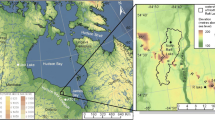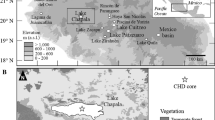Abstract
A consequence of predicted climate warming will be tree-line advance over large areas of the Russian tundra. Palaeolimnological techniques can be used to provide analogues of how such changes in tree-line advance and subsequent retreat affected lake ecosystems in the past. A Holocene sediment core taken from Kharinei Lake (Russia) was dated radiometrically and used for multi-proxy analyses with the aim of determining how climate and tree-line dynamics affected the productivity, community structure, carbon cycling and light regime in the lake. Pollen and macrofossil analyses were used to determine the dates of the arrival and retreat of birch and spruce forest. C:N ratios and percent loss-on-ignition were used to infer past changes in sediment organic matter. Visible-near-infrared spectroscopy and diatom analysis were used to infer past changes in lake-water carbon. Algal pigments and aquatic macrophytes were used to determine changes in lake productivity and light. Chironomids together with remains of the aquatic flora and fauna were used to provide information on past July temperature and continentality. Lake sedimentation was initiated shortly before 11,000 cal. years BP, when both chironomid- and pollen-inferred temperature reconstructions suggest higher summer temperatures than present, between 1 and 2°C warmer, and lake productivity was relatively high. A few trees were already present at this time. The spruce forest expanded at 8,000 cal. year BP remaining in the vicinity of the lake until 3,500 cal. year BP. This period coincided with a high concentration of organic material in the water column, and relatively high benthic productivity, as indicated by a high benthic: planktonic diatom ratio. After tree-line retreat, the optical transparency of the lake increased, and it became more open and exposed, and was thus subject to greater water-column mixing resulting in a higher abundance of diatom phytoplankton, especially heavily silicified Aulocoseira species. The colder climate resulted in a shorter ice-free period, the lake was less productive and there was a loss of aquatic macrophytes. Increased wind-induced mixing following forest retreat had a greater influence on the lake ecosystem than the effects of decreasing organic matter concentration and increased light penetration.







Similar content being viewed by others
References
Andreev AA, Tarasov PE, Ilyashuk B et al (2005) Holocene environmental history recorded in Lake Lyadhej-To sediments, Polar Urals, Russia. Palaeogeogr Palaeoclimatol Palaeoecol 223:181–203
Battarbee RW, Jones VJ, Flower RJ, Cameron NG, Bennion H, Carvalho L (2001) Diatoms. In: Smol JP, Birks HJB, Last WM (eds) Tracking environmental change using lake sediments. Volume 3: terrestrial, algal and siliceous indicators. Kluwer Academic, Dordrecht
Bennett KG (1996) Determination of the number of zones in a biostratigraphical sequence. New Phytol 132:55–170
Berger A (1978) Long-term variations of daily insolation and quaternary climatic changes. J Atmos Sci 35:2362–2367
Bradbury P, Cumming B, Laird K (2002) A 1500-year record of climatic and environmental change in Elk Lake, Minnesota III: measures of past primary productivity. J Paleolimnol 27:321–340
Brodin YW (1986) The postglacial history of Lake Flarken, southern Sweden, interpreted from subfossil insect remains. Int Rev Ges Hydrobiol 71:371–432
Bronk-Ramsey C (2010) Bayesian analysis of radiocarbon dates. Radiocarbon 51:337–360
Brooks SJ, Langdon PG, Heiri O (2007) The identification and use of Palaearctic Chironomidae larvae in palaeoecology. Quaternary Research Association Technical Guide, pp 276
Cameron NG, Birks HJB, Jones VJ et al (1999) Surface-sediment and epilithic diatom pH calibration sets for remote European mountain lakes (AL:PE project) and their comparison with the Surface Waters Acidification Programme (SWAP) calibration set. J Paleolimnol 22:291–317
Getsen MV (1966) Algae of the tundra lakes. In: Belyaev GM, Vinberg GG, Gaevskaya NS (eds) Hydrobiological studies and fish resources of lakes from extreme North of the USSR. Nauka, Moscow, pp 22–50
Gorczynski W (1920) Sur le calcul du degré de continentalisme et son application dans la climatologie. Geogr Ann 2:324–331
Heegaard E, Birks HJB, Telford RJ (2005) Relationships between calibrated ages and depth in stratigraphical sequences: an estimation procedure by mixed-effect regression. The Holocene 15:612–618
Hubberten HW, Andreev A, Astakhov VI et al (2004) The periglacial climate and environment in northern Eurasia during the Last Glaciation. Quat Sci Rev 23:1333–1357
Huisman J, Sharples J, Stroom JM, Visser PM, Kardinaal WE, Verspagen JMH, Sommeijer B (2004) Changes in turbulent mixing shift competition for light between phytoplankton species. Ecology 85:2960–2970
Jones VJ, Birks HJB (2004) Lake-sediment records of recent environmental change on Svalbard: results of diatom analysis. J Paleolimnol 31:445–466
Jonsson A, Karlsson J, Jansson M (2003) Sources of carbon dioxide supersaturation in clearwater and humic lakes in Northern Sweden. Ecosystems 6:224–235
Juggins S (1991) Zone. University of Newcastle, UK
Juggins S (2007) C2 Version 1.5: software for ecological and palaeoecological data analysis and visualisation [program]. University of Newcastle, UK
Karlsson J, Byström P (2005) Littoral energy mobilization dominates energy supply for top consumers in subarctic lakes. Limnol Oceanogr 50:538–543
Karlsson J, Jonsson A, Meili M, Jansson M (2003) Control of zooplankton dependence on allochthonous organic carbon in humic and clear-water lakes in northern Sweden. Limnol Oceanogr 48:269–276
Kremenetski CV, Sulerzhitsky LD, Hantemirov R (1998) Holocene history of the northern range limits of some shrubs and trees in Russia. Arct Alp Res 30:317–333
Kultti S, Väliranta M, Sarmaja-Korjonen K, Solovieva N, Virtanen T, Kaupilla T, Eronen M (2003) Palaeoecological evidence of changes in vegetation and climate during the Holocene in the pre-Polar Urals, northeast European Russia. J Quat Sci 18:503–520
Kultti S, Oksanen PO, Väliranta M (2004) Holocene tree line, permafrost, and climate dynamics in the Nenets region, East European Arctic. Can J Earth Sci 41:1141–1158
Lampinen R, Lahti T (2007) Kasviatlas 2006 (vegetation atlas). Botanical Museum, Finnish Museum of Natural History, Helsinki
Leavitt PR (1993) A review of factors that regulate carotenoid and chlorophyll deposition and fossil pigment abundance. J Paleolimnol 9:109–127
Leavitt PR, Hodgson DA (2001) Sedimentary pigments. In: Smol JP, Birks HJB, Last WM (eds) Tracking environmental changes using lake sediments. Kluwer Academic Publishers, Dordrecht, pp 295–325
Leavitt PR, Cumming B, Smol JP, Reasoner MA, Pienitz R, Hodgson DA (2003) Climatic control of ultraviolet radiation effects on lakes. Limnol Oceanogr 48:2062–2069
MacDonald GM, Velichko AA, Kremenetski CV et al (2000) Holocene treeline history and climate change across northern Eurasia. Quat Res 53:302–311
Mangerud J, Svendsen JI, Astakhov VI (1999) Age and extent of the Barents and Kara ice sheets in Northern Russia. Boreas 28:46–80
McGowan S, Juhler R, Anderson N (2008) Autotrophic response to lake age, conductivity and temperature in two West Greenland lakes. J Paleolimnol 39:301–317
Paus A, Svendsen JI, Matiouchkov A (2003) Late Weichselian (Valdaian) and Holocene vegetation and environmental history of the northern Timan Ridge, European Arctic Russia. Quat Sci Rev 22:2285–2302
Pienitz R, Smol JP, Birks HJB (1995) Assessment of freshwater diatoms as quantitative indicators of past climatic change in the Yukon and Northwest Territories, Canada. J Paleolimnol 13:21–49
Pienitz R, Smol JP, MacDonald GM (1999) Paleolimnological reconstruction of Holocene climatic trends from two boreal treeline lakes, Northwest Territories, Canada. Arct Antarct Alp Res 31:82–93
Porinchu DF, Cwynar LC (2000) The distribution of freshwater Chironomidae (Insecta: Diptera) across treeline near the lower Lena River, northeast Siberia, Russia. Arct Antarct Alp Res 32:429–437
Porinchu DF, Cwynar LC (2002) Late-quaternary history of midge communities and climate from a tundra site near the lower Lena River, Northeast Siberia. J Paleolimnol 27:59–69
Reimer PJ, Baille MGL, Bard E, Bayliss A, Beck JW et al (2009) INTCAL 09 and MARINE09 radiocarbon age calibration curves, 0–50,000 years Cal BP. Radiocarbon 51:1111–1150
Reuss NS, Hammarlund D, Rundgren M, Segerström U, Eriksson L, Rosén P (2010a) Lake ecosystem responses to Holocene climate change at the sub-arctic tree-line in Northern Sweden. Ecosystems 13:393–409
Reuss NS, Leavitt PR, Hall RI, Bigler C, Hammarlund D (2010b) Development and application of sedimentary pigments for assessing effects of climatic and environmental changes on subarctic lakes in northern Sweden. J Paleolimnol 43:149–169
Rosén P (2005) Total organic carbon (TOC) of lake water during the Holocene inferred from lake sediments and near-infrared spectroscopy (NIRS) in eight lakes from northern Sweden. Biogeochemistry 76:503–516
Rühland K, Smol JP (1998) Limnological characteristics of 70 lakes spanning arctic treeline from Coronation Gulf to Great Slave Lake in the Central North West Territories, Canada. Int Rev Hydrobiol 83:183–203
Rühland K, Paterson A, Smol JP (2008) Hemispheric-scale patterns of climate-related shifts in planktonic diatoms from North American and European lakes. Glob Chang Biol 14:2740–2754
Salonen JS, Seppä H, Väliranta M, Jones VJ, Self AE, Heikkilä M, Kultti S (2011) The Holocene thermal maximum and late-Holocene cooling in the tundra of NE European Russia. Quat Res 75:501–511
Self AE (2010) The relationship between chironomids and climate in high latitude Eurasian lakes: implications for reconstructing Late Quaternary climate variability from subfossil chironomid assemblages in lake sediments from northern Russia. PhD, University College London
Self AE, Brooks SJ, Birks HJB, Nazarova L, Porinchu D, Odland A, Yang H Jones VJ (2011) The distribution and abundance of chironomids in high-latitude Eurasian lakes with respect to temperature and continentality: development and application of new chironomid-based climate-inference models in northern Russia. Quat Sci Rev 30:1122–1141
Smol JP, Wolfe AP, Birks HJB et al (2005) Climate-driven regime shifts in the biological communities of arctic lakes. Proc Natl Acad Sci USA 10:4397–4402
Solovieva N, Jones VJ, Dauvalter V, Appleby P, Kondratenok B (2002) Extent, environmental impact and long-term trends in atmospheric contamination in the USA basin of East-European Russian Arctic. Water Air Soil Pollut 139:237–260
Solovieva N, Jones VJ, Birks HJB et al (2005) Palaeolimnological evidence for recent climate change in lakes from the northern Urals, Arctic Russia. J Paleolimnol 33:463–482
Solovieva N, Jones VJ, Birks HJB, Appleby P, Nazarova L (2008) Diatom responses to 20th century climate warming in lakes from the northern Urals, Russia. Palaeogeogr Palaeoclimatol Palaeoecol 259:96–106
Stenin VN (1972) Peculiarities of diatom flora in the modern glacial lakes from the Polar Urals. Scientific reports of higher school. Biol Sci (in Russian) 5:66–73
Stevenson AC, Juggins S, Birks HJB et al (1991) The surface waters acidification project palaeolimnology programme: modern Diatom/Lake-Water chemistry data-set. ENSIS Ltd, London
Svendsen JI, Alexanderson H, Astakhov VI et al (2004) Late quaternary ice sheet history of northern Eurasia. Quat Sci Rev 23:1229–1271
R Development Core Team (2008) R: a language and environment for statistical computing. R Foundation for Statistical Computing, Vienna, Austria. http://www.R-project.org
ter Braak CJF, Šmilauer P (2002) CANOCO Reference manual and CANODRAW for windows user’s guide: software for canonical community ordination (version 4.5). Ithaca, NY
Väliranta M (2006) Long-term changes in aquatic plant species composition in North-eastern European Russia and Finnish Lapland, as evidenced by plant macrofossil analysis. Aquat Bot 85:224–232
Väliranta M, Kultti S, Seppä H (2006) Vegetation dynamics during the Younger Dryas-Holocene transition in the extreme northern taiga zone, northeastern European Russia. Boreas 35:202–212
Virtanen T, Mikkola K, Christensen JH, Mazhitova GG, Oberman N, Kuhry P (2004) Modeling the location of the forest line in Northeast European Russia with remotely sensed vegetation and GIS-based climate and terrain data. Arct Antarct Alp Res 36:314–322
Acknowledgments
This work was funded by a NERC studentship (NER/S/A/2005/13227), and EU Carbo-North, (Contract No. 036993). We would like to thank Handong Yang at the Bloomsbury Environmental Isotope Facility (BEIF) at UCL for 210Pb dating. Vasily Ponomorov KSC is thanked for his help with field work. Samples were radiocarbon dated at the NERC Radiocarbon Facility (Environment) and SUERC AMS Laboratory, East Kilbride, UK under allocation numbers 1243.1007 and 1289.0408. The comments of two anonymous referees are also gratefully acknowledged.
Author information
Authors and Affiliations
Corresponding author
Rights and permissions
About this article
Cite this article
Jones, V.J., Solovieva, N., Self, A.E. et al. The influence of Holocene tree-line advance and retreat on an arctic lake ecosystem: a multi-proxy study from Kharinei Lake, North Eastern European Russia. J Paleolimnol 46, 123–137 (2011). https://doi.org/10.1007/s10933-011-9528-7
Received:
Accepted:
Published:
Issue Date:
DOI: https://doi.org/10.1007/s10933-011-9528-7




